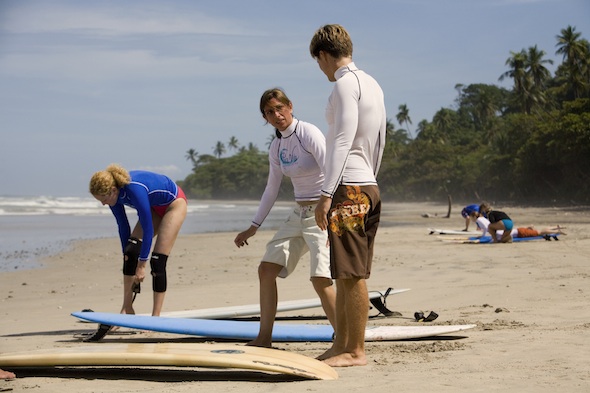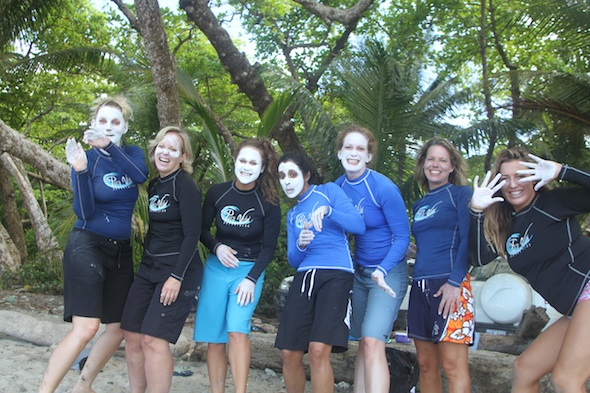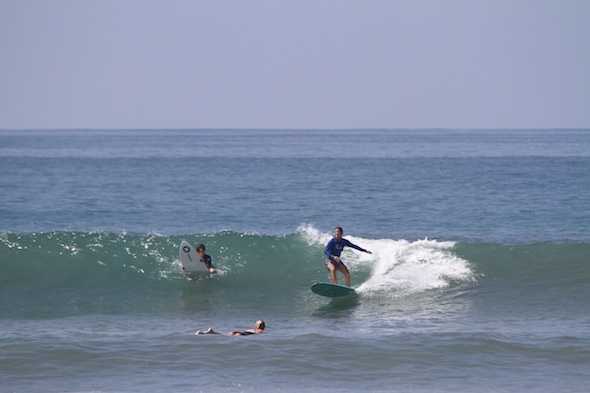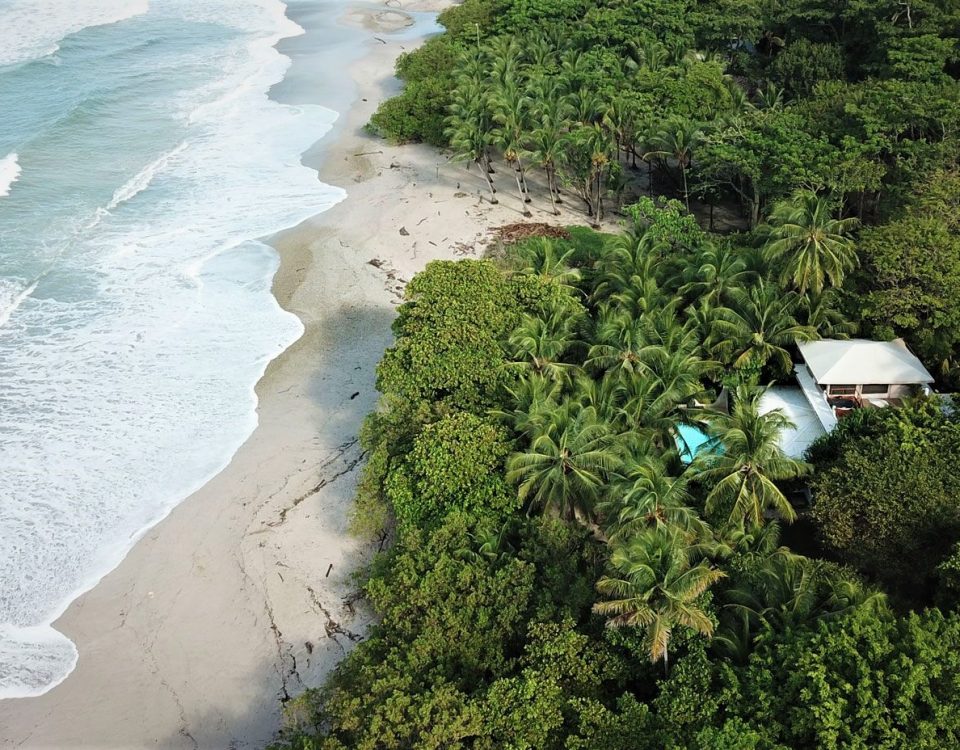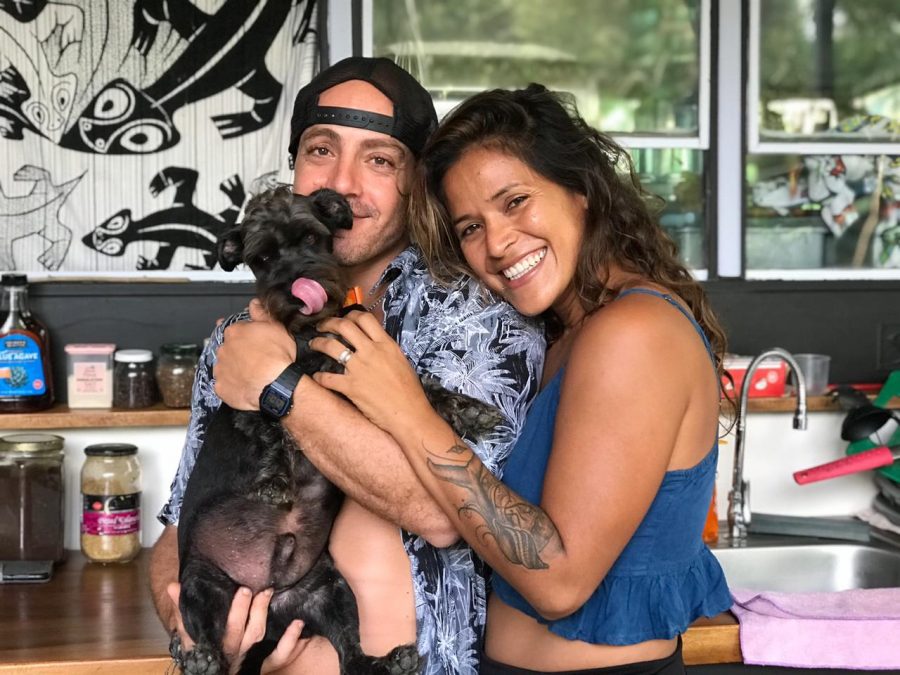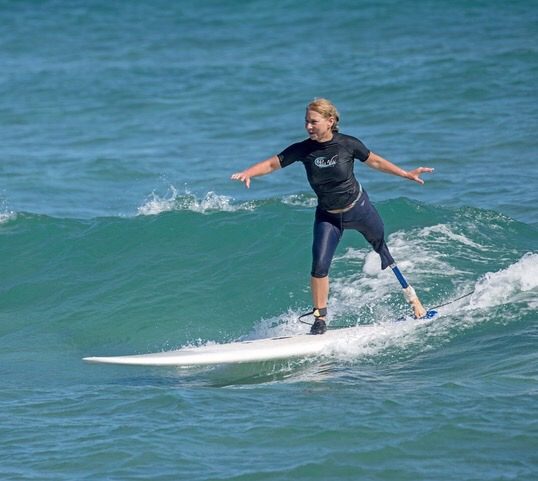A Week in the Pura Vida Life – by Anna Davies

Loa “Brown Bear” ~ A Love Story
August 12, 2014
Where Your Soul Can Hear and Your Heart Can Listen
October 15, 2014A Week in the Pura Vida Life – by Anna Davies
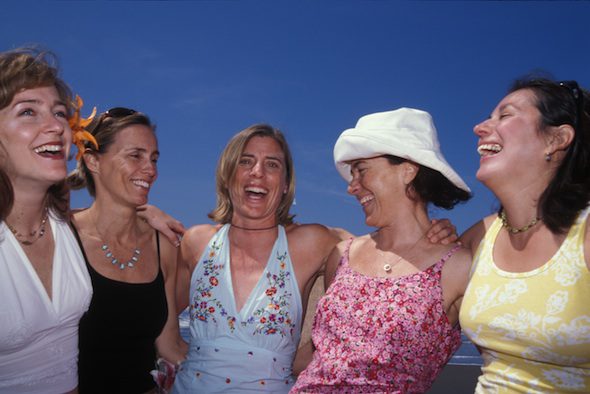
Pre-Departure:
Why surf camp?
That’s a question I’ve been getting a lot whenever I tell people where I’m spending the week. I answer based on how well I know the person. For the random acquaintances, it’s that I’ve always loved the idea of swimming. After all, I was a high school swimmer and spent my summers in college lifeguarding and working as a waterfront camp counselor. The water feels like home.
I also like the idea of picking up surfing as a sport. Lately, I’ve discovered the music of Tristan Prettyman via Pandora. Tristan is a singer/songwriter/surfer chick. She embodies the surfer girl aesthetic—athletic, confident, the type of person who’s at ease on the top of the wave or in a crowd of people. That’s who I want to be—because, truthfully, for the past year, ever since my mom’s death from cancer, I’m not sure who I am anymore.
My mom was my biggest supporter. She wasn’t my best friend—she hated that term applied to parents and children. And without her, I’ve felt lost. Maybe I think surfing will ground me.
So I began my research. I’d heard awesome things about Pura Vida Adventures, I read the More Magazine write-up on Pura Vida, and had also read the story on TheFrisky.com written by Amelia McDonnell-Parry. Amelia is an editor-acquaintance, so when we ended up at a mutual friend’s brunch in the city, I asked her about it. She was enthused, and I was sold.
Day One:
The plane lands in San Jose and I am proud to use my elementary Spanish to navigate to the tiny domestic offshoot terminal where I’ll take the flight to Tambor. There, I notice a woman who’s about my age. I debate over introducing myself, then decide to wait. I get nervous on small planes and don’t want to freak out in front of her.
Turns out, the flight was fine and she is going to Pura Vida, as well. We share a cab across the landscape—which is dusty–with glimpses of the so-incredibly-blue ocean. Monkeys hang from trees and I feel a million miles away from NYC. By the end of the one hour ride, I can tell Kristen (my cab companion) and I are going to be friends.
We get to Hotel Tropico Latino. It’s beautiful—tiny bungalows nestled among lush foliage and a clear view of the beach. We’re met by Scott Eichner, Pura Vida’s owner and Tierza’s husband. As he gives us the lay of the land; I realize he looks incredibly familiar. After a short name-game, I discover we were both camp counselors at the same camp in 2002. Now, I know I made the right decision.
Kristen and I end up roommates and we head to our room, pull on our bikinis, and join a few other girls on the beach. They’re drinking homemade rum and cokes. As we sit and watch the waves—knowing that we’ll be surfing them tomorrow—I feel incredibly happy.
Later, we have an official welcome meeting on the yoga deck. Tierza asks each camper to explain why they came. I hug my knees to my chest, unsure if I’ll give the real reason. But as each woman explains her situation, the answer becomes clear.
Tierza nods after everyone speaks. “It’s special here. Things change. I’ve seen it.” At dinner, overlooking the ocean and surrounded by the sea air, everyone feels like old friends. I know I made the right decision and I’m so happy to be here.
Day Two:
The day starts with yoga on the yoga deck, taught by Cristina, otherwise known as Kalyani. She is tiny, soft-spoken, and strong. She greets everyone with a smile and asks about our yoga experience. I have a “meh” relationship with yoga. I go through phases where I’m into it, then phases where I ignore it. But yoga outside is way better than yoga in NYC studios. I can hear the surf and, occasionally, iguanas land on the canvas roof, causing everyone to jump.
After yoga, our breakfast includes an awesome I-can’t-believe-this-is-healthy smoothie, then the group convenes for some surfing 101. We get the lowdown on catching waves, what to look out for, and we’re fitted for rash guards. Then we head to the beach, where we lie in the sand and learn the pop-up (the explosive move that gets the surfer to stand up on the board and catch the wave). My yoga and gym-going has paid off. On land, at least, my pop-up looks strong.
After a couple more rounds of “one-two-three-POP UP” commands from the instructors, I’m surprised when we’re actually allowed to get into the water. I’d been expecting the day to be mostly on land, but now we stand waist-deep in the waves, holding our boards. The boards are way heavier than I imagined.
“Climb on,” my instructor, Brett, suggests, hitting the spot where I should lie. A weird coincidence–the lead instructor, Brett, grew up in my New Jersey hometown. I like having him as my instructor. He’s patient and low-key, but also incredibly detail-oriented. Even doing pop-ups on the beach, he corrected minor things, like foot positioning and landing advice. But land is different than water, and I feel uneven and wobbly as a wave crests under the board.
“Okay, ready?” He asks.
“Yeah.” No. I like swimming, but the board just feels unwieldy and different.
“Okay. Then paddle … paddle,” he coaches as I pull my arms through the water and try to stay steady. “Pop up!” he yells. I don’t. I feel the wave swell and push me, but I ride it like I’m body surfing.
Bottom line: I’m scared.
A few women have gone to camp before, and they’re already on top of the waves. I’m still getting used to it when we leave for lunch.
“I’ll do it tomorrow,” I said confidently. I’m not frustrated. I’m in a beautiful place, I’m outside, and all of us are shouting encouragement or laughing at our semi-wipeouts.
Once we get back to the hotel, we clean up and head to Brisas del Mar, a restaurant on the top of the hill, settling into a table just as the sun is sinking into the sky. It’s gorgeous, the sangria is flowing, and none of us can stop laughing. After dinner, all of us convene on the oversized futons on the camp porch, laughing and drinking. Some of us are single, some are married, and about twenty years separates the oldest and youngest in the group. But here, none of that matters.
Day Three:
“Ow,” is my first thought upon waking up. My shoulders are sore, my legs are tight, and I have an angry stripe of red on my lower back from where I wasn’t diligent enough with sunscreen. The sun is no joke here, which is why the surf instructors all strongly encourage—and use themselves—zinc. Does having a mime-like white face look ridiculous? Kind of, but everyone’s doing it.
Today, I realize why yoga is part of the program. By the end of the one-hour session, I feel less tight and ready to face the waves.
The morning session is more of the same—at least for me. Some of the ladies are catching waves, but I’m still: hop on, paddle, miss, repeat. I know I’ll get it, but I also hate that I’m not there yet. Truthfully, I’m a little relieved when we break for lunch.
Lunch is at Zula, a middle eastern restaurant with amazing hummus. Surfing—or learning to surf—works up an amazing appetite. Not only that, but it’s great to be surrounded by women who are eating, and enjoying, their food. Working in media, my peers often order salad, so I’m psyched not to feel guilty about my “can we have more pita” type requests.
There’s an optional surf session that afternoon, and some women are heading on a canopy tour of the jungle. I decide against either. My shoulders hurt, I’m scared of heights, and, quite honestly, the idea of chilling by the pool with a drink sounds pretty awesome.
But first, Kristen and I decide to explore the town. “Town” is a small strip of outdoor restaurants and tiny shops along a dusty road. Midday, the heat is so strong that we’re dripping of sweat, but I enjoy an iced coffee from a European-owned bakery and enjoy people watching.
That night, the entire group heads to Mary’s Restaurant in Malpais. It’s known for fresh fish–the food is incredible. The conversation is flowing. I love hearing stories about how the instructors ended up here. Tonight, I’m sitting near George, a British surf instructor whose whistles signal when to pop-up. He’s philosophical about surfing, seeing it as a way to connect with the natural world, which he feels people don’t do nearly enough of. I agree.
When we get back, it’s only nine thirty, but everyone’s exhausted. I sleep well here, falling fast asleep when my head hits the pillow and waking up when the alarm goes off. Unlike my routine back home, where I hit snooze as much as I can, I’m genuinely ready to get up and am often the first to yoga. I wish I could keep this attitude when I return to New York. It’s Pura Vida, baby.
Day Four:
I can’t believe I’ve only been here a few days. My rashguard is covered with wax, all of my bikinis are hanging on our bungalow deck to dry, and our room has a messy trail of clothes and toiletries everywhere. In fact, the only thing in my bag is the board shorts I bought—I didn’t like them and never used them. All the real surfer girls—and the instructors—wear bikini bottoms with the strings pulled tight so they won’t fall off. I’m a long way off from a real surfer girl, but I like feeling like one when I pull my salt-crusted hair into a ponytail, or brush Nu-Skin onto the blisters that have formed on my hands and feet.
I discovered the magic of the midday nap, or any time siesta. My roomie and I now call the oversized day bed on the porch “sleepy couch.” Any time we sit down on it for more than five minutes, we end up falling into a delicious nap.
And on the surfing front? Things are okay. I can sometimes pop up. But most of the time, I’m still too late, too tentative. It’s a metaphor for my life—I tend to hesitate when I should go. Surfing doesn’t have time for that.
Luckily, I booked an afternoon massage and I revel in it.
Before dinner, a few of us head down the beach to watch the sun set. We get drinks at a beachside bar and look out at the surf, while discussing what we need to work on. Talking to the other girls pulls me out of the “ugh, why can’t I do this?” funk. The instructors are awesome, offering suggestions and correcting form, but hearing compliments from my peers like, “you looked really strong” and “ I know you’re going to be awesome” is rewarding.
Day Five:
There’s another reason why I felt weird all day yesterday. And that is because I was freaked out by the thought of today.
A year ago— during my first day on the job at Cosmo (my dream magazine)—I saw my parent’s number flash on my cell. I was momentarily annoyed that they were interrupting me. I answered. It was my Dad, saying my mother was in the ICU and things weren’t looking good. My mother had lymphoma and was progressively getting sicker. But until that moment, I hadn’t known how far it had spread. And I hadn’t known that the doctors didn’t think she’d make it out of the hospital this time.
I hung up and screamed—actually screamed—in the corporate office on the 38th floor of a Manhattan tower. My new coworkers peeked up from their cube. At the same time, I reflexively yanked off my necklaces and they puddled on the laminate counter. I’d worn two wishbone necklaces that day—one tiny, one a medium size pendant. “For double luck,” I’d explained to my then boyfriend. Right. One broke immediately. The other had seamlessly unhinged at the clasp. I wore this one now, even in the water, even surfing.
“Stop it.”
I’m in yoga, moving through Sun Salutations. I try to focus on the moment, on my postures, on making sure my hips are even, that my knees aren’t locked. But I can’t shake the memories, and they follow me into the water.
That morning, I’m just plain off. My hand slips off the board, I can’t seem to figure out the right time to pop up, and I ignore wave after wave. Finally, after falling off my board again, I angrily get out of the water, take of my leash, and walk down the sand. Niqui, one of the instructors, follows me.
“I’m fine.” I avoid eye contact. I’m not fine and we both know it. And I also don’t want to keep everything bottled up. Hesitantly, I explain what today is, annoyed at myself with the way my voice cracks. I am twenty-nine years old. I am fine.
“It’s all right. The water knows when you’re upset,” she says. I nod. “And I’m so sorry about that. I bet she [your mom] would be happy that you were here.”
“She wouldn’t!” I wail. I almost laugh at how childlike I sound. “I mean,” I explain, “My mom was so worried about everything. She’d be scared of me surfing. She didn’t even like me driving.”
Niqui nods and looks up at the sky. “Well, we’re doing it safely.” She winks. In the moment, it was the exact right thing to say.
That night, I skip the hang out and head down the beach by myself. At first I walk. But then, I start running, faster and faster, until I can’t breathe. As the sun is setting, I sink into the sand on my hands and knees and cry, harder than I have in the past year. This is what I was scared of and this is what I needed: an ugly, angry, heaving, physical cry. I’m not sure how long it lasted, but all of a sudden the tears stop and I feel all the fear and the anger shift. I head back to the hotel feeling exhausted and achy and a million times better. I’d been afraid of this day for a year. And I got through it.
That night at dinner, we go to Basta Pasta. It’s loud and raucous and a few of the single girls flirt with a group of Australian surfer dudes. I join in. And I agree—my mom would have loved to see me living it up.
Day Six:
Today, I feel like a different person on my board—and it shows. There are still a few tentative moments—when I scoot to my knees instead of jumping to my feet, or when I lean back, brake-like, on the board—but they are few and far between. Today is what I thought surfing would be like. I’m disappointed when the session ends for lunch.
During lunch, George mentions that I’ve improved. I explain my emotional release, the crying on the beach. It’s weird how surfing has such a mind/body connection that’s different than other sports. When I was a swimmer in high school, my entire mentality was to just push myself through a set and make myself work hard, then harder. But that’s not the way surfing works. It’s a dance with the water, it’s knowing and trusting yourself, allowing your brain to get rid of everything besides that wave. I realize I’m hooked.
That night, dinner is at the hotel, followed by a casual beer and talk gathering on the beach. Later, a group of us drift back to Basta Pasta for more drinks and conversation. It’s hard to explain the connection I feel to the other women without sounding corny. But I came with no expectations and I’ve had amazing conversations, gotten a ton of perspective, and really felt accepted and supported in a way that’s not always easy in the real world.
Day Seven:
It’s the last day—really, just a half-day before we fly out—and the late-night celebrating prevented most from making the pre-breakfast surf session, except for my roommate and I. We fall into step down the beach, carrying our surfboards. The board used to feel heavy and unwieldy; now it’s comfortable under my arms.
In the water, we truly play. The waves are gentle, and we’re riding more than we’re falling down. We watch each other, impressed at how far we’ve come. Later at lunch, we make plans to surf back in New York City. And ,as everyone says goodbye, I know it’s more than lip-service. It was awesome to meet them, we will look each other up.
I’m so psyched a place like Pura Vida exists. Tierza was right: magic did happen. Already, I’m planning my next trip. My first book will publish soon and something tells me I’ll need an extra confidence boost before then …
You can follow freelance writer Anna Davies on twitter @annakdavies.

